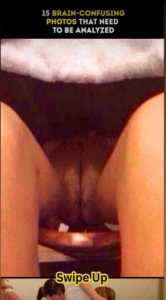15 Brain-Confusing Photos That Need to Be Analyzed
In the age of social media, where every scroll brings a new surprise, some photos stop us in our tracks — not because of how beautiful or dramatic they are, but because they make our brains glitch. These are the kinds of pictures that demand a second (or third!) look. Maybe it’s a floating cat. Or a man with a dog’s body. Or an infinite staircase to nowhere.
Let’s dive into 15 brain-confusing photos — not just to admire them, but to analyze what tricks our minds into seeing the impossible.
1. The Floating Cat
At first glance, it looks like a cat is hovering above the floor. The reality? The cat is sitting on a glass table. The glass is so clean and clear that it disappears in the image, creating the illusion of levitation.
Analysis: Our brain interprets images based on context and prior knowledge — in this case, it fails to register the invisible glass support.
2. The Dog-Human Hybrid
You might see a man walking with a dog… until you realize the man’s head seems to be on the dog’s body. In fact, the dog is jumping, and the man is bent over at just the right angle behind it.
Analysis: Perfect alignment and poor depth cues confuse our perception, blending two separate figures into one.
3. The Infinite Staircase
This famous photo looks like a real-life Penrose staircase — one that loops forever. How? By clever camera angles and architectural tricks.
Analysis: This illusion plays with linear perspective, manipulating depth so that flat surfaces appear three-dimensional and endless.
4. The Missing Shadow
A man walks on a sunny beach — but his shadow is nowhere to be seen. Upon closer look, the sand is completely white and sunlit from above, erasing shadow contrast.
Analysis: Our brain expects shadows to fall in certain ways. When lighting is diffused or from directly overhead, the lack of expected shadow triggers confusion.
5. The Girl with No Legs
A group photo shows a smiling girl whose torso seems to float — her legs mysteriously missing. Turns out, she’s sitting on another girl’s lap, whose pants match the background.
Analysis: Camouflage and blending disrupt object segmentation, a core part of how our brain distinguishes one thing from another.
6. The Backwards Bike
This one’s a real mind-bender: a bicycle appears to have its wheels reversed — as if the front wheel is where the back should be. But it’s just a trick of an oddly designed frame and perspective.
Analysis: When visual geometry violates our expectation of symmetry, the brain struggles to resolve the image into something logical.
7. The Giant Baby
A baby looks massive — towering over buildings and streets like Godzilla. It’s a forced perspective photo: the baby is much closer to the camera than the background.
Analysis: Without strong depth cues, our brain merges foreground and background, leading to surreal scale distortion.
8. The Leg Swap
Two friends pose for a photo, and something looks off — it seems their legs are swapped! One is wearing long pants that match the ground, creating a disappearing effect.
Analysis: Strong pattern matching tricks the eye, hiding edges and confusing figure-ground perception.
9. The Waterfall That Goes Up
This waterfall photo appears to defy gravity, with water flowing upward. But it’s actually a clever sideways image — rotate it 90 degrees and everything makes sense.
Analysis: Orientation expectations heavily influence how we interpret motion and gravity in photos.
10. The Twinless Mirror
A woman stands in front of a mirror — but her reflection is missing. In reality, it’s not a mirror at all, but a perfectly synchronized twin standing in a fake frame.
Analysis: Our brain is trained to interpret frames as mirrors, so we fall for the substitution instantly.
11. The Building That Melts
Some modern architecture uses wavy, mirrored surfaces that make buildings appear to melt or ripple. In photos, this creates the illusion of a structure that’s flowing like water.
Analysis: Our perception expects rigidity in buildings, so fluid lines break that model and induce a surreal effect.
12. The Headless Horseman Photo
A rider appears headless, galloping on horseback. The truth? The rider is bent forward, and the horse’s neck and mane cover their head completely.
Analysis: Occlusion is key in image understanding — when key body parts are hidden, the mind fills in (or omits) details in odd ways.
13. The Mirror Tunnel Illusion
In this photo, two mirrors face each other, creating an infinite tunnel of reflections. A person stands in the middle, but their body seems to vanish into an endless hall of selves.
Analysis: The brain struggles with recursive reflections — it knows what a mirror is but gets lost in the repeating feedback loop.
14. The Broken Floor
This illusion is created on purpose — a 3D floor painting shows a huge chasm opening beneath your feet. It’s flat, but the shading and perspective trick make it feel like you’re about to fall in.
Analysis: Trompe-l’œil (“trick the eye”) art uses depth shading and forced perspective to override your sense of flatness.
15. The Disappearing Rail
A train track photo shows rails that seem to vanish into thin air. But it’s an effect of fog and perfect symmetry — as the track recedes into the distance, the atmospheric conditions erase detail.
Analysis: Linear perspective combined with environmental obscuration causes the vanishing point to blend into infinity.
Why Do These Photos Trick Us?
Our brains are pattern recognition machines, and most of the time, they’re shockingly good at interpreting reality. But these optical illusions and visual puzzles reveal the cracks in that system. Here’s why:
-
Assumptions: The brain uses shortcuts and prior experience to make sense of images quickly. When a photo violates those expectations (e.g., size, position, color), the brain stalls.
-
Perspective: Without clear reference points or with intentional manipulation of angles, our sense of depth and distance can be warped.
-
Lighting and Shadows: Our perception of space and form is heavily influenced by light cues. When shadows behave unusually, confusion follows.
-
Camouflage and Context: When colors and patterns blend seamlessly, the brain has trouble separating objects from backgrounds.
Final Thoughts
Brain-confusing photos aren’t just good for entertainment — they teach us how fragile and fascinating our perception really is. In a world filled with visual information, our brains are constantly working to filter, interpret, and decide what’s “real.” But as these 15 images show, reality is sometimes stranger — and more flexible — than we think.

